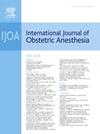十加十等于二十:一项评估硬膜外注射注射器大小和速度的前瞻性交叉研究
IF 2.3
3区 医学
Q2 ANESTHESIOLOGY
引用次数: 0
摘要
背景:对于紧急产时剖宫产,硬膜外导管应尽快加入~ 20ml局麻药。在我们的机构,紧急局麻药被吸入两个10毫升的注射器,而不是一个20毫升的注射器,因为相信通过两个10毫升的注射器注射药物更快。然而,目前尚不清楚使用两个10毫升的注射器是否真的更快。我们的假设是,使用一个20ml注射器通过硬膜外导管注射20ml比使用两个10ml注射器注射20ml更快。方法在本研究中,20名麻醉专业人员定时通过硬膜外导管注射20 mL水(模拟局麻溶液),各使用20 mL注射器和2支10 mL注射器。参与者被指示注射,就像他们正在为紧急剖宫产注射硬膜外麻醉一样。分析采用配对t检验。结果20 mL注射器的平均注射时间为41.77 s±11.16,2支10 mL注射器的平均注射时间为43.32 s±7.40 (P = 0.338)。男性注射1支20 mL与2支10 mL的时间差异有统计学意义(分别为37.81秒±11.22比41.52秒±8.10,P = 0.028),女性无统计学差异。结论1支20ml注射器与2支10ml注射器的注射速度无明显差异,麻醉医师可以选择自己最舒适的大小。本文章由计算机程序翻译,如有差异,请以英文原文为准。
Ten plus ten equals twenty: a prospective crossover study evaluating syringe size and speed of epidural injection
Background
For emergent intrapartum cesarean delivery, epidural catheters are dosed as quickly as possible with ∼20 mL of local anesthetic. At our institution, emergency local anesthetics are drawn into two 10 mL syringes, as opposed to a single 20 mL syringe, due to the belief that it is faster to inject medication via two 10 mL syringes. However, it is unclear if using two 10 mL syringes is actually faster. Our hypothesis was that injecting 20 mL through an epidural catheter using one 20 mL syringe is faster than injecting 20 mL using two 10 mL syringes.
Methods
In this study, 20 anesthesia professionals were timed while injecting 20 mL of water (simulating a local anesthetic solution) through an epidural catheter using each method, a 20 mL syringe and two 10 mL syringes. Participants were instructed to inject as if they were dosing an epidural for an emergent cesarean delivery. Analysis was by paired-t-test.
Results
The mean time of injection was 41.77 seconds ± 11.16 with the 20 mL syringe and 43.32 seconds ± 7.40 with the two 10 mL syringes (P = 0.338). There was, however, a statistically significant difference among men injecting through one 20 mL vs. two 10 mL syringes (37.81 seconds ± 11.22 vs. 41.52 seconds ± 8.10, respectively; P = 0.028), but not among women.
Conclusions
There was no difference in injection speed between one 20 mL syringe and two 10 mL syringes, suggesting that anesthesiologists can use whatever size is most comfortable for them.
求助全文
通过发布文献求助,成功后即可免费获取论文全文。
去求助
来源期刊
CiteScore
4.70
自引率
7.10%
发文量
285
审稿时长
58 days
期刊介绍:
The International Journal of Obstetric Anesthesia is the only journal publishing original articles devoted exclusively to obstetric anesthesia and bringing together all three of its principal components; anesthesia care for operative delivery and the perioperative period, pain relief in labour and care of the critically ill obstetric patient.
• Original research (both clinical and laboratory), short reports and case reports will be considered.
• The journal also publishes invited review articles and debates on topical and controversial subjects in the area of obstetric anesthesia.
• Articles on related topics such as perinatal physiology and pharmacology and all subjects of importance to obstetric anaesthetists/anesthesiologists are also welcome.
The journal is peer-reviewed by international experts. Scholarship is stressed to include the focus on discovery, application of knowledge across fields, and informing the medical community. Through the peer-review process, we hope to attest to the quality of scholarships and guide the Journal to extend and transform knowledge in this important and expanding area.

 求助内容:
求助内容: 应助结果提醒方式:
应助结果提醒方式:


